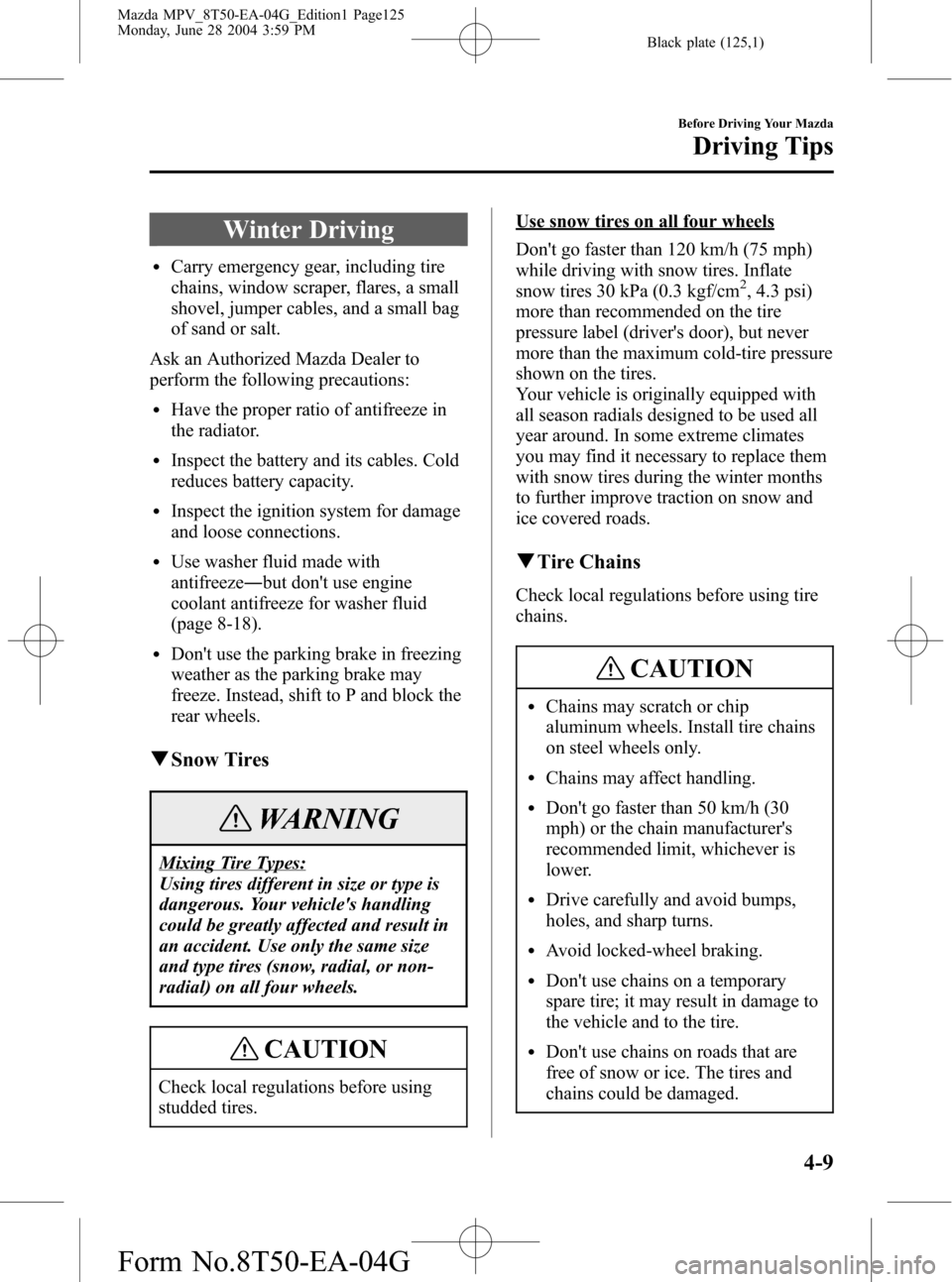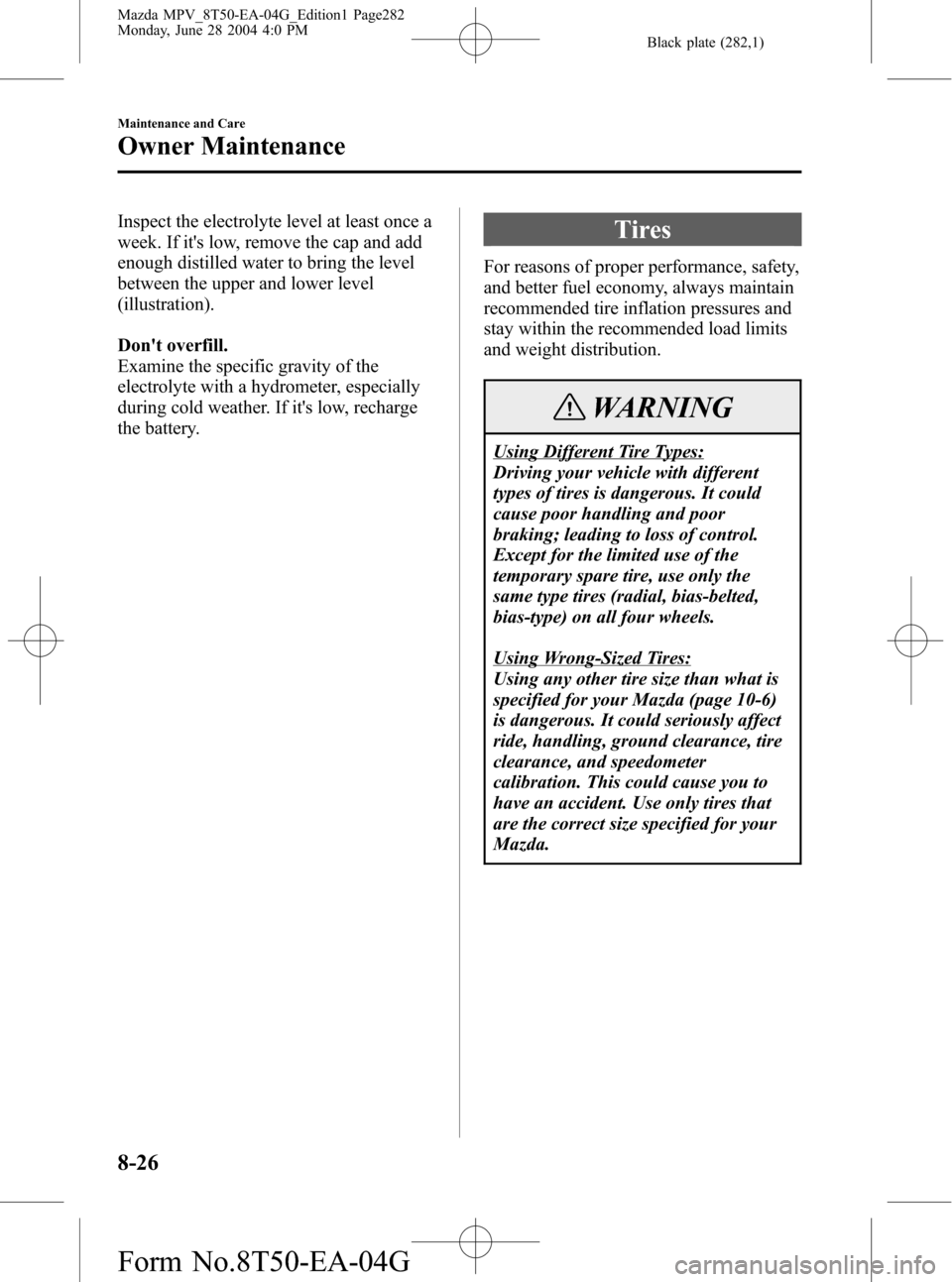wheel size MAZDA MODEL MPV 2005 Owners Manual (in English)
[x] Cancel search | Manufacturer: MAZDA, Model Year: 2005, Model line: MODEL MPV, Model: MAZDA MODEL MPV 2005Pages: 336, PDF Size: 5.31 MB
Page 69 of 336

Black plate (69,1)
WARNING
Air Bags without Seat Belts:
Depending only on the air bags for protection during an accident is dangerous. Alone,
air bags may not prevent serious injuries. The appropriate air bags can be expected to
inflate only in collisions with frontal, near frontal or side forces that are at least
moderate. Vehicle occupants should always wear seat belts.
Child in the Front Seat:
Placing a child, 12 years or under, in the front seat is dangerous. The child could be
hit by a deploying air bag and be seriously injured or even killed. Even if the front
passenger air bag deactivation indicator light illuminates, always move the front
passenger seat as far back as possible. A sleeping child is more likely to lean against
the door and be hit by the side air bag in a moderate, right-side collision. Whenever
possible, always secure a child 12 years and under on the rear seats with an
appropriate child-restraint system for the child's age and size.
Rear-Facing Child-Restraint System:
Rear-facing child-restraint systems on the front seat are particularly dangerous.
The child-restraint system can be hit by a deploying air bag and moved violently
backward resulting in serious injury or death to the child. Even though you may feel
assured that the front passenger air bag will not deploy based on the fact that the front
passenger air bag deactivation indicator light illuminates, NEVER use a rear-facing
child-restraint system in the front seat with an air bag that could deploy even in a
moderate collision.
Seating Position with Front Air Bags:
Sitting too close to the air bag modules or placing hands or feet on them is extremely
dangerous. Front air bags inflate with great force and speed. Serious injuries could
occur if someone is too close. The driver should always hold onto only the rim of the
steering wheel. The front seat passenger should keep both feet on the floor. Front seat
occupants should adjust their seats as far back as possible and always sit upright
against the seatbacks with seat belts worn properly.
Essential Safety Equipment
SRS Air Bags
2-57
Mazda MPV_8T50-EA-04G_Edition1 Page69
Monday, June 28 2004 3:59 PM
Form No.8T50-EA-04G
Page 125 of 336

Black plate (125,1)
Winter Driving
lCarry emergency gear, including tire
chains, window scraper, flares, a small
shovel, jumper cables, and a small bag
of sand or salt.
Ask an Authorized Mazda Dealer to
perform the following precautions:
lHave the proper ratio of antifreeze in
the radiator.
lInspect the battery and its cables. Cold
reduces battery capacity.
lInspect the ignition system for damage
and loose connections.
lUse washer fluid made with
antifreeze―but don't use engine
coolant antifreeze for washer fluid
(page 8-18).
lDon't use the parking brake in freezing
weather as the parking brake may
freeze. Instead, shift to P and block the
rear wheels.
qSnow Tires
WARNING
Mixing Tire Types:
Using tires different in size or type is
dangerous. Your vehicle's handling
could be greatly affected and result in
an accident. Use only the same size
and type tires (snow, radial, or non-
radial) on all four wheels.
CAUTION
Check local regulations before using
studded tires.
Use snow tires on all four wheels
Don't go faster than 120 km/h (75 mph)
while driving with snow tires. Inflate
snow tires 30 kPa (0.3 kgf/cm
2, 4.3 psi)
more than recommended on the tire
pressure label (driver's door), but never
more than the maximum cold-tire pressure
shown on the tires.
Your vehicle is originally equipped with
all season radials designed to be used all
year around. In some extreme climates
you may find it necessary to replace them
with snow tires during the winter months
to further improve traction on snow and
ice covered roads.
qTire Chains
Check local regulations before using tire
chains.
CAUTION
lChains may scratch or chip
aluminum wheels. Install tire chains
on steel wheels only.
lChains may affect handling.
lDon't go faster than 50 km/h (30
mph) or the chain manufacturer's
recommended limit, whichever is
lower.
lDrive carefully and avoid bumps,
holes, and sharp turns.
lAvoid locked-wheel braking.
lDon't use chains on a temporary
spare tire; it may result in damage to
the vehicle and to the tire.
lDon't use chains on roads that are
free of snow or ice. The tires and
chains could be damaged.
Before Driving Your Mazda
Driving Tips
4-9
Mazda MPV_8T50-EA-04G_Edition1 Page125
Monday, June 28 2004 3:59 PM
Form No.8T50-EA-04G
Page 241 of 336

Black plate (241,1)
Changing a Flat Tire
NOTE
If the following occurs while driving, it
could indicate a flat tire.
lSteering becomes difficult.
lThe vehicle begins to vibrate
excessively.
lThe vehicle pulls in one direction.
If you have a flat tire, drive slowly to a
level spot that is well off the road and out
of the way of traffic to change the tire.
Stopping in traffic or on the shoulder of a
busy road is dangerous.
WARNING
Jacking a Vehicle:
Changing a tire is dangerous if not
done properly. The vehicle can slip off
the jack and seriously injure someone.
Be sure to follow the directions for
changing a tire, and never get under a
vehicle that is supported only by a
jack.
Passenger in Vehicle Supported by a
Jack:
Allowing someone to remain in a
vehicle supported by a jack is
dangerous. The occupant could cause
the vehicle to fall resulting in serious
injury. Never allow anyone inside a
vehicle supported by a jack.
NOTE
Make sure the jack is well lubricated
before using it.1. Park on a level surface off the right-of-
way and firmly set the parking brake.
2. Shift into Park (P) and turn off the
engine.
3. Turn on the hazard warning flasher.
4. Have everyone get out of the vehicle
and away from the vehicle and traffic.
5. Remove the jack, tool, and spare tire
(page 7-3).
6. Block the wheel diagonally opposite
the flat tire. When blocking a wheel,
place a block both in front and behind
the tire.
NOTE
When blocking a tire, use rocks or
wood blocks of sufficient size to hold
the tire in place.
CAUTION
If the jack leans towards the front or the
rear when jacking up, lower the vehicle
until the wheels are firmly on the
ground. Then confirm that the parking
brake is set, the shift lever is in Park
(P), then push the blocks firmly under
the blocked tire.
In Case of an Emergency
Flat Tire
7-9
Mazda MPV_8T50-EA-04G_Edition1 Page241
Monday, June 28 2004 4:0 PM
Form No.8T50-EA-04G
Page 282 of 336

Black plate (282,1)
Inspect the electrolyte level at least once a
week. If it's low, remove the cap and add
enough distilled water to bring the level
between the upper and lower level
(illustration).
Don't overfill.
Examine the specific gravity of the
electrolyte with a hydrometer, especially
during cold weather. If it's low, recharge
the battery.Tires
For reasons of proper performance, safety,
and better fuel economy, always maintain
recommended tire inflation pressures and
stay within the recommended load limits
and weight distribution.
WARNING
Using Different Tire Types:
Driving your vehicle with different
types of tires is dangerous. It could
cause poor handling and poor
braking; leading to loss of control.
Except for the limited use of the
temporary spare tire, use only the
same type tires (radial, bias-belted,
bias-type) on all four wheels.
Using Wrong-Sized Tires:
Using any other tire size than what is
specified for your Mazda (page 10-6)
is dangerous. It could seriously affect
ride, handling, ground clearance, tire
clearance, and speedometer
calibration. This could cause you to
have an accident. Use only tires that
are the correct size specified for your
Mazda.
8-26
Maintenance and Care
Owner Maintenance
Mazda MPV_8T50-EA-04G_Edition1 Page282
Monday, June 28 2004 4:0 PM
Form No.8T50-EA-04G
Page 285 of 336

Black plate (285,1)
CAUTION
lDon't use your temporary spare tire
rim with a snow tire or a
conventional tire. Neither will
properly fit and could damage both
tire and rim.
lThe temporary spare tire has a tread
life of up to 5,000 km (3,000 miles),
depending on road conditions and
driving habits.
lThe temporary spare tire is for
limited use, however, if the tread
wear solid-band indicator appears,
replace the tire with the same type of
temporary spare (page 8-28).
qReplacing a Wheel
WARNING
Using a Wrong-Sized Wheel:
Using a wrong-sized wheel is
dangerous. Braking and handling
could be affected, leading to loss of
control and an accident. Always use
wheels of the correct size on your
vehicle.
CAUTION
A wrong-sized wheel may adversely
affect:
lTire fit
lWheel and bearing life
lGround clearance
lSnow-chain clearance
lSpeedometer calibration
lHeadlight aim
lBumper height
When replacing a wheel, make sure the
new one is the same as the original factory
wheel in diameter, rim width, and offset.
Proper tire balancing provides the best
riding comfort and helps reduce tread
wear. Out-of-balance tires can cause
vibration and uneven wear, such as
cupping and flat spots.
Maintenance and Care
Owner Maintenance
8-29
Mazda MPV_8T50-EA-04G_Edition1 Page285
Monday, June 28 2004 4:0 PM
Form No.8T50-EA-04G
Page 329 of 336

Black plate (329,1)
Standard tire
Item Model
Tire size 205/65R15 94H 215/60R16 95H P215/60R17 95H
Rim size 15×6JJ
*1, 15×6J*216×6-1/2J 17×7J
Inflation pressure 240 kPa (35 psi or lb/po2) 240 kPa (35 psi or lb/po2) 240 kPa (35 psi or lb/po2)
*1 Steel wheel
*2 Alloy wheel
Temporary spare tire
Tire size Inflation pressure
T135/90D15 420 kPa (60 psi)
qFuses
Refer to the fuse rating on page 8-36.
Specifications
10-7
Mazda MPV_8T50-EA-04G_Edition1 Page329
Monday, June 28 2004 4:1 PM
Form No.8T50-EA-04G